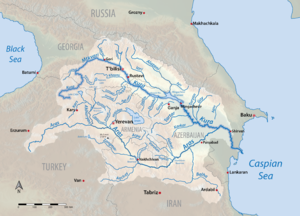Mtkvari
| Kura (Mtkvari) | |
|
At Mtskheta, Georgia
|
|
| Name origin: Related to the name of Cyrus the Great | |
| Countries | Turkey, Georgia, Azerbaijan |
|---|---|
| Region | Caucasus |
| Part of | Caspian Sea basin |
| Tributaries | |
| - left | Liakhvi, Aragvi, Iori, Alazani |
| - right | Algeti, Khrami, Tartarchay, Aras |
| Cities | Khashuri, Gori, Borjomi, Tbilisi, Rustavi, Mingacevir, Zardab, Sabirabad, Neftçala |
| Source | Lesser Caucasus |
| - location | Near Kartsakhi Lake, Kars, Turkey |
| - elevation | 2,740 m (8,990 ft) |
| - coordinates | 40°40′31″N 42°44′32″E / 40.67528°N 42.74222°E |
| Mouth | Caspian Sea |
| - location | Neftçala, Neftchala Rayon, Azerbaijan |
| - elevation | −26.5 m (−87 ft) |
| - coordinates | 39°19′32″N 49°20′07″E / 39.32556°N 49.33528°ECoordinates: 39°19′32″N 49°20′07″E / 39.32556°N 49.33528°E |
| Length | 1,515 km (941 mi) |
| Basin | 198,300 km2 (76,564 sq mi) |
| Discharge | for directly downstream from Aras River confluence |
| - average | 443 m3/s (15,644 cu ft/s) |
| - max | 2,250 m3/s (79,458 cu ft/s) |
| - min | 206 m3/s (7,275 cu ft/s) |
|
Kura River Basin
|
|
The Kura (Turkish: Kura; Azerbaijani: Kür; Georgian: მტკვარი, Mt'k'vari; Kurdish: rûbara kur; Armenian: Կուր, Kur; Ancient Greek: Cyrus; Persian: Kurosh ) is an east-flowing river south of the Greater Caucasus Mountains which drains the southern slopes of the Greater Caucasus east into the Caspian Sea. It also drains the north side of the Lesser Caucasus while its main tributary, the Aras drains the south side of those mountains. Starting in northeastern Turkey, it flows through Turkey to Georgia, then to Azerbaijan, where it receives the Aras as a right tributary, and enters the Caspian Sea. The total length of the river is 1,515 kilometres (941 mi).
People have inhabited the Caucasus region for thousands of years, and first established agriculture in the Kura Valley over 4,500 years ago. Large, complex civilizations eventually grew up on the river, but by 1200 CE, most were reduced to ruin by natural disasters and foreign invaders. The increasing human use, and eventual damage, of the watershed’s forests and grasslands contributed to a rising intensity of floods through the 20th century. In the 1950s, the Soviet Union started building many dams and canals on the river. Previously navigable up to Tbilisi in Georgia, it is now much slower and shallower, as its power has been harnessed by hydroelectric power stations. The river is now moderately polluted by major industrial centers like Tbilisi and Rustavi in Georgia.
...
Wikipedia


